 |
|
|
| (Information by Peter Kessler, with additional information by Edward Dawson, from The Landscape of King Arthur, Geoffrey Ashe, from The Cambridge Historical Encyclopaedia of Great Britain and Ireland, Christopher Haigh (Ed), from The Oxford History of England: Roman Britain, Peter Salway, from A History of the English Church and People, The Venerable Bede (Leo Sherley-Price translation - revised by R E Latham), and from External Links: Mote of Mark (Royal Commission on the Ancient and Historical Monuments of Scotland), and 'Lost kingdom' linked to Galloway (BBC News), and The fiery demise of a vitrified hillfort in Scotland (Past Horizons, dead link).) |
|
|
|
|
|
|
|
|
| c.485 |
The son of Cinuit of Alt Clut, Tutgwal Theodovellaunus, establishes himself in Galwyddel, perhaps as a legitimate division of Alt Clut on his father's death, with such a division being an entirely normal and customary practise in Celtic kingdoms. It also seems that he and his successors rule Ynys Manau at the same time. However, if the order of succession for Alt Clut is correct, then the continual shift between two branches of the royal house may hint at a civil war or successional struggle which has since been forgotten. 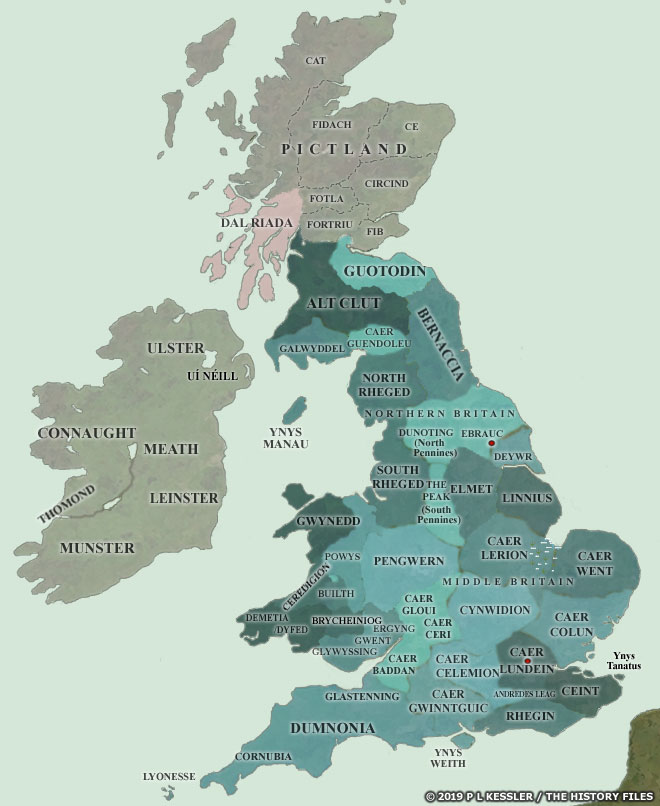 This map of Britain concentrates on British territories and kingdoms which were established during the fourth and fifth centuries AD, as the Saxons and Angles began their settlement of the east coast (click or tap on map to view full sized) This map of Britain concentrates on British territories and kingdoms which were established during the fourth and fifth centuries AD, as the Saxons and Angles began their settlement of the east coast (click or tap on map to view full sized) |
|
| c.485? - c.495 |
Tutgwal Theodovellaunus ap Cinuit |
Son of King Cinuit of Alt Clut. Also king of Alt Clut (c.490-495). |
| Dingat ap Tutgwal |
Son. Also ruled Ynys Manau. |
|
| fl c.550 |
Sennylt ap Dingat |
Son. Exiled to Ynys Manau. |
| c.550 |
Galwyddel is invaded by North Rheged and is annexed to that kingdom. Sennylt flees with his family to Ynys Manau. How Rheged may have managed an invasion when it seemingly doesn't share a land border with Galwyddel is a simple matter to answer. Caer-Guendoleu apparently stretches down to the head of the Solway Firth, blocking Rheged's land access to Galwyddel, but Guendoleu and Rheged are allies (they do not fight each other in the battle of AD 573), so there's no reason to suppose that Rheged's warband would not be permitted to pass through Guendoleu's territory to reach Galwyddel. Records are so lacking in detail, though, that Guendoleu's warband could ride with them and it will never be known. This would also seem a likely point for the reoccupation of an early hill fort at Rockcliffe, overlooking Rough Firth (the Urr Estuary) approximately twenty-five kilometres to the south-west of Dumfries. Today it is known as the Mote of Mark (after King Mark of Cornwall, perhaps due to confusion - both he and the conqueror of Galwyddel, Cynfarch Oer, have fathers named Meirchion). 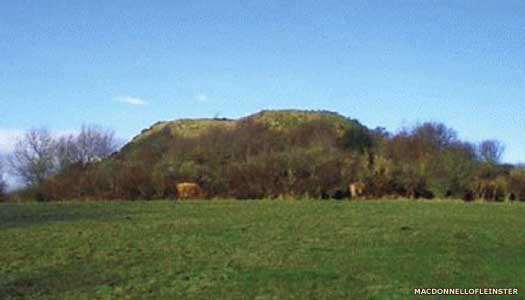 The Mote of Mark was a pre-Roman hill fort which was reoccupied around the mid-sixth century AD, and is often linked (erroneously) to King Mark of Cornwall The Mote of Mark was a pre-Roman hill fort which was reoccupied around the mid-sixth century AD, and is often linked (erroneously) to King Mark of Cornwall |
|
| The fort is occupied from the sixth century and has a seaward side which falls sharply away to the water, while on the landward side is a rampart, a drystone wall in a timber frame, one of the few partial British parallels to Cadbury Castle. This rampart does not go all the way around, and the protected enclosure is much smaller, just sixty-one metres by forty metres. Inside, fragments of metal and jewellery prove the presence of craftsmen and a rich patron. |
|
|
| c.590s |
Christianity is known to flourish in Galloway around this time, in the form of the British Church. Archaeologists later discover Celtic crosses from this period in layers beneath the building which precedes the later Whithorn Priory, and more such finds are made at St Ninian's Cave. Early English runes which are found on the crosses are later additions. |
|
| fl c.597 |
? |
Three unnamed 'chiefs of Novant' involved in the Gododdin. |
| c.597 |
The Gododdin is a long series of elegies which are composed from the early seventh century onwards, principally by Aneirin, son of Dunaut of Dunoting. It commemorates a force of Britons who assemble near Edinburgh at this time in preparation for facing their powerful foe. 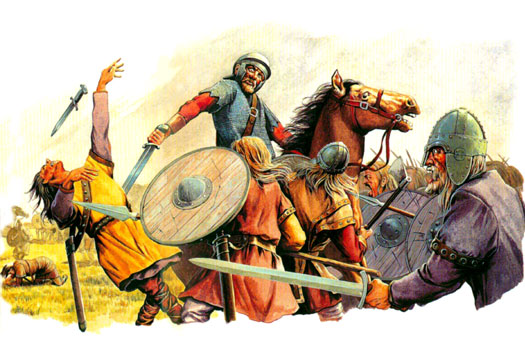 The attack against the Angles at the end of the sixth century appears to have been a last-ditch attempt by the semi-Romanised Britons to rid the land of these invaders - and it failed, albeit gloriously The attack against the Angles at the end of the sixth century appears to have been a last-ditch attempt by the semi-Romanised Britons to rid the land of these invaders - and it failed, albeit gloriously |
|
It includes not only the Guotodin themselves, but warriors from all over the country, including 'three chiefs of Novant', clearly the nearby Novantae in post-Roman form. This force marches south to fight the Angles at Catreath (generally accepted as being modern Catterick, approximately eighty kilometres north of Ebrauc). It seems strange that they should march past Bamburgh on their way, the capital of the early Bernician kingdom, but perhaps not if they are making an attempt to reclaim the lost capital of the north, Ebrauc. The battle seems to take place during an attack against the Roman fort near the strategic road junction now called Scotch Corner, by the south bank of the Swale at Catterick Bridge. Gwawrddur is praised for 'glutting black ravens on the wall of the fort, though he was not Arthur' (a term used to denote great slaughter of the enemy, but even so this warrior is still not a match for Britain's heroic battle leader of the previous century). Ultimately, the battle is a disaster for the Britons. The flower of the Northern British warrior class is decimated by the superior numbers of the Bernicians. Guotodin, as well as the other kingdoms of the north, probably including Elmet, are all fatally weakened by the defeat. 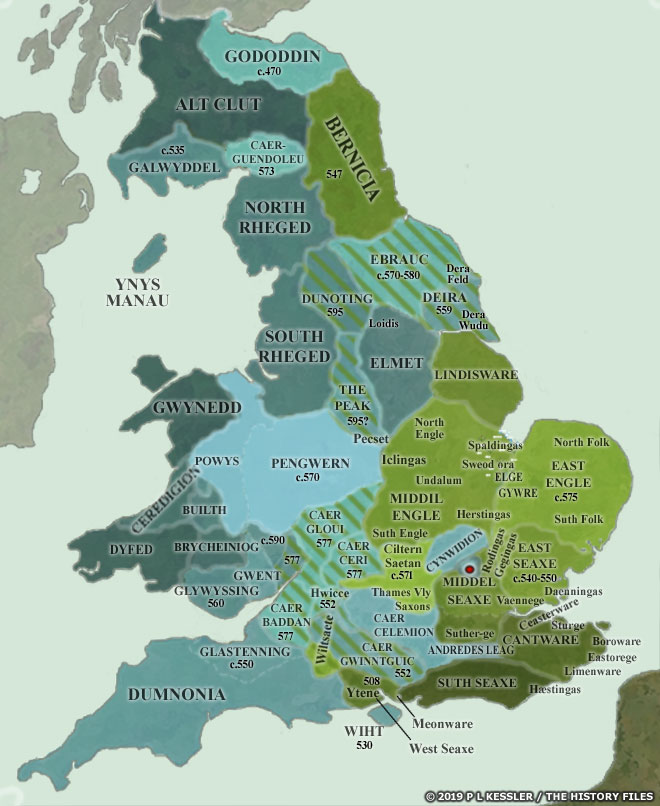 At the start of this period, the Angle and Saxon kingdoms on the east and south coasts were firmly established. Many of the rapidly-formed Romano-British territories in those areas had been swept away in the late fifth century (click or tap on map to view full sized) At the start of this period, the Angle and Saxon kingdoms on the east and south coasts were firmly established. Many of the rapidly-formed Romano-British territories in those areas had been swept away in the late fifth century (click or tap on map to view full sized) |
|
|
| c.600 |
Published early in 2017, archaeological research at Trusty's Hill Fort at Gatehouse of Fleet in 2012 determines that, in this period, the hill fort is an important royal stronghold. It is claimed as a place of religious, cultural, and political innovation. Work begins on the site after Pictish symbols are found carved onto bedrock here, these being unique in this region and far to the south of locations in which Pictish carvings are normally found. This supports Pictish occupation of the region despite the broad swathe of Britons to their north and east (later arrivals in the region who largely displaced their predecessors in Early Britain). The carvings are found to relate directly to the royal stronghold which serves as a place of inauguration for the region's locals. This in turn suggests that the site is important to the Galloway Picts prior to the arrival of North Rheged as an overlord, although it is possible that Rheged re-uses the site. The claim that it is the capital of the kingdom of Rheged is entirely erroneous, perhaps delivered to improve sales of an accompanying book. 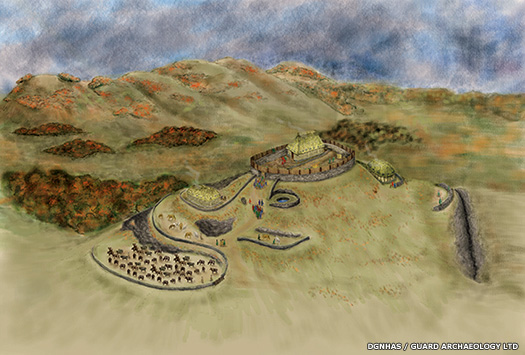 Excavation work discovered that Trusty's Hill Fort at Gatehouse of Fleet in Galloway was the seat of a royal court, probably that of the region's chieftains both before and after occupation by Rheged Excavation work discovered that Trusty's Hill Fort at Gatehouse of Fleet in Galloway was the seat of a royal court, probably that of the region's chieftains both before and after occupation by Rheged |
|
| One finding is that the fort appears to be deliberately destroyed in the early seventh century. In fact it is subjected to such a sustained burning that the timber-laced stone rampart circling its summit is vitrified. The evidence from empirical experiments and from a range of archaeological sites demonstrates that this is certainly a destructive not a creative process, and is deliberate not accidental. Aggression by various groups in northern Britain is certainly attested during this period. However, it is early in the seventh century that the king of Bernicia conquers and makes tributary much of Rheged's territory, including Galloway. Interestingly, all of the vitrified forts in central Galloway lie within or very close to parishes in which clusters of early Anglian settlement can be discerned from place-name evidence, indicating not only a political, but also an attempted cultural purge around the middle of the seventh century AD. |
|
|
| c.616 |
The remnants of North Rheged collapse after being overrun by Edwin of Bernicia, although there is the possibility that an enclave remains. It seems that Bernician, and later Northumbrian, influence is felt in Galloway from around this point, although perhaps only following a period of autonomy. 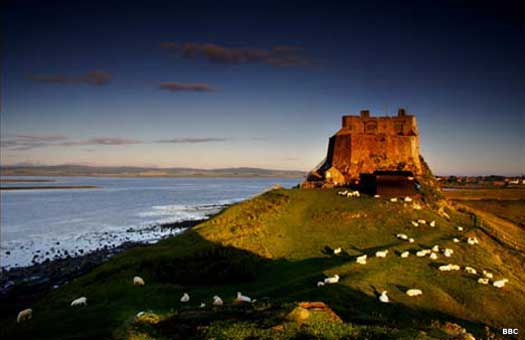 The isle of Lindisfarne, or Ynys Metcaut to the British, remained the fortress by which the Angles held onto their kingdom in the face of repeated British attacks, but Din Guayroi or Guarie (Bamburgh Castle) shown here may have been another The isle of Lindisfarne, or Ynys Metcaut to the British, remained the fortress by which the Angles held onto their kingdom in the face of repeated British attacks, but Din Guayroi or Guarie (Bamburgh Castle) shown here may have been another |
|
| The Mote of Mark fort, reoccupied in the sixth century, is destroyed by fire in the seventh century. This is possibly during the collapse of North Rheged and takes place in the same time at which Trusty's Hill Fort is destroyed. |
|
|
| 731 |
The Northumbrian bishopric of hwit ærn (Whithorn) is established. Galwyddel's history is thereafter very vague, but it seems likely that it follows the general sequence for Strathclyde until its permanent inclusion in eleventh century Scotland. |
|
 |
|
|
 With the expulsion of Roman officials in AD 409 (see feature link), Britain again became independent of Rome and was not re-occupied. The fragmentation which had begun to emerge towards the end of the fourth century now appears to have accelerated, with minor princes, newly declared kings, and Roman-style magistrates all vying for power and influence while also facing the threat of extinction at the hands of the various barbarian tribes which were encroaching from all sides. A territory by the name of Galwyddel actually uses the the later Welsh version of a northern British name. It can also be included in records in its Gaelic version, as Gallgeidhael. Today it is better known as Galloway, in south-western Scotland. It emerged following the departure of Roman administration in the country. Its territory may largely have fallen within Novantae tribal territory prior to the Roman arrival in the first century AD. Apparently its post-Roman appearance was as a division of the 'Kingdom of Northern Britain' (again, a later title which was used to describe the administration of the Romano-British north). It may not have become a recognisable region straight away though. Initially, in the fifth century the Picts of Galwyddel appear to have been governed from Ynys Manau, before being acquired by the growing kingdom of Rheged. The regional capital of Dun Rheged was formed at this time (Dunragit, near Stranraer, fairly close to Whithorn in the west of the region). The area of Rhinns (the long 'nose' peninsula to the south-west of Stranraer) and Machars (which incorporates Wigtown and Whithorn) both show signs of Christian activity in the fourth and fifth centuries. Both areas contain memorial stones and church dedications for this period. This is contemporary (or nearly so) with similar finds in Carlisle and the Wall which were controlled by Rheged, but there is a clear territorial gap between these locations and those of Galwyddel within which there is very little evidence of Christianity. Possibly this is a sign of limited but successful British Church missionary activity from Carlisle across the Solent which failed to penetrate eastwards. The alternative is early missionary activity from Ireland into Galwyddel. According to the few scraps of information which survive, Rheged seized Galloway in the mid-sixth century. Dunragit emerged as an important site around this time but, in early 2017, archaeologists announced that they had found a royal centre at Trust's Hill Fort at Gatehouse of Fleet (also in the west of the region). Despite mistakenly attributing this to the royal seat of power, the site was certainly an important one. However, once Rheged collapsed in stages between 595-638, the region apparently fell under Ynys Manau's control again. It remained independent of its neighbour, Alt Clut, until AD 900, its occupants continuing to be recognised as Picts who were separate from the northern Britons of the area. Soon after that, probably as the Vikings invaded Ynys Manau, Strathclyde (Alt Clut) absorbed Galwyddel. Its name, however, lives on in modern Galloway.
With the expulsion of Roman officials in AD 409 (see feature link), Britain again became independent of Rome and was not re-occupied. The fragmentation which had begun to emerge towards the end of the fourth century now appears to have accelerated, with minor princes, newly declared kings, and Roman-style magistrates all vying for power and influence while also facing the threat of extinction at the hands of the various barbarian tribes which were encroaching from all sides. A territory by the name of Galwyddel actually uses the the later Welsh version of a northern British name. It can also be included in records in its Gaelic version, as Gallgeidhael. Today it is better known as Galloway, in south-western Scotland. It emerged following the departure of Roman administration in the country. Its territory may largely have fallen within Novantae tribal territory prior to the Roman arrival in the first century AD. Apparently its post-Roman appearance was as a division of the 'Kingdom of Northern Britain' (again, a later title which was used to describe the administration of the Romano-British north). It may not have become a recognisable region straight away though. Initially, in the fifth century the Picts of Galwyddel appear to have been governed from Ynys Manau, before being acquired by the growing kingdom of Rheged. The regional capital of Dun Rheged was formed at this time (Dunragit, near Stranraer, fairly close to Whithorn in the west of the region). The area of Rhinns (the long 'nose' peninsula to the south-west of Stranraer) and Machars (which incorporates Wigtown and Whithorn) both show signs of Christian activity in the fourth and fifth centuries. Both areas contain memorial stones and church dedications for this period. This is contemporary (or nearly so) with similar finds in Carlisle and the Wall which were controlled by Rheged, but there is a clear territorial gap between these locations and those of Galwyddel within which there is very little evidence of Christianity. Possibly this is a sign of limited but successful British Church missionary activity from Carlisle across the Solent which failed to penetrate eastwards. The alternative is early missionary activity from Ireland into Galwyddel. According to the few scraps of information which survive, Rheged seized Galloway in the mid-sixth century. Dunragit emerged as an important site around this time but, in early 2017, archaeologists announced that they had found a royal centre at Trust's Hill Fort at Gatehouse of Fleet (also in the west of the region). Despite mistakenly attributing this to the royal seat of power, the site was certainly an important one. However, once Rheged collapsed in stages between 595-638, the region apparently fell under Ynys Manau's control again. It remained independent of its neighbour, Alt Clut, until AD 900, its occupants continuing to be recognised as Picts who were separate from the northern Britons of the area. Soon after that, probably as the Vikings invaded Ynys Manau, Strathclyde (Alt Clut) absorbed Galwyddel. Its name, however, lives on in modern Galloway.
 This map of Britain concentrates on British territories and kingdoms which were established during the fourth and fifth centuries AD, as the Saxons and Angles began their settlement of the east coast (click or tap on map to view full sized)
This map of Britain concentrates on British territories and kingdoms which were established during the fourth and fifth centuries AD, as the Saxons and Angles began their settlement of the east coast (click or tap on map to view full sized) The Mote of Mark was a pre-Roman hill fort which was reoccupied around the mid-sixth century AD, and is often linked (erroneously) to King Mark of Cornwall
The Mote of Mark was a pre-Roman hill fort which was reoccupied around the mid-sixth century AD, and is often linked (erroneously) to King Mark of Cornwall The attack against the Angles at the end of the sixth century appears to have been a last-ditch attempt by the semi-Romanised Britons to rid the land of these invaders - and it failed, albeit gloriously
The attack against the Angles at the end of the sixth century appears to have been a last-ditch attempt by the semi-Romanised Britons to rid the land of these invaders - and it failed, albeit gloriously At the start of this period, the Angle and Saxon kingdoms on the east and south coasts were firmly established. Many of the rapidly-formed Romano-British territories in those areas had been swept away in the late fifth century (click or tap on map to view full sized)
At the start of this period, the Angle and Saxon kingdoms on the east and south coasts were firmly established. Many of the rapidly-formed Romano-British territories in those areas had been swept away in the late fifth century (click or tap on map to view full sized) Excavation work discovered that Trusty's Hill Fort at Gatehouse of Fleet in Galloway was the seat of a royal court, probably that of the region's chieftains both before and after occupation by Rheged
Excavation work discovered that Trusty's Hill Fort at Gatehouse of Fleet in Galloway was the seat of a royal court, probably that of the region's chieftains both before and after occupation by Rheged The isle of Lindisfarne, or Ynys Metcaut to the British, remained the fortress by which the Angles held onto their kingdom in the face of repeated British attacks, but Din Guayroi or Guarie (Bamburgh Castle) shown here may have been another
The isle of Lindisfarne, or Ynys Metcaut to the British, remained the fortress by which the Angles held onto their kingdom in the face of repeated British attacks, but Din Guayroi or Guarie (Bamburgh Castle) shown here may have been another